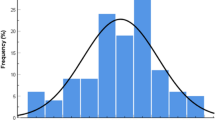Abstract
Cucumber downy mildew caused byPseudoperonospora cubensis (Berk. and Curt.) Rostov. limits crop production in Shandong Province of China. Since management of downy mildew is strongly dependent on fungicides, a rational design of control programs requires a good understanding of the fungicide resistance phenomenon in field populations of the pathogen. A total of 106 and 97 isolates ofP. cubensis were obtained in 2006 and 2007, respectively. The EC50 values for the growth of all the 106 isolates collected in 2006 were 0.0063–0.0688µg ml−1 (average: 0.0196±0.0048µg ml−1) azoxystrobin and these were therefore considered sensitive isolates. However, 57 field isolates ofP. cubensis of the 97 collected in 2007 with EC50 values that ranged from 0.609 to >51.2µg ml−1 were considered resistant to azoxystrobin. Fragments of the fungicide-targeted mitochondrial cytochromeb gene from total pathogen DNA were amplified using polymerase chain reaction and their sequences analyzed to elucidate the molecular mechanism of resistance. A single point mutation (GGT to GCT) in the cytochromeb gene, resulting in substitution of glycine by alanine at position 143, was found in the three selected azoxystrobin-resistant isolates of downy mildew. This substitution in cytochromeb exhibited different resistance levels, with the resistance factor from 21.15 to greater than 2618.9. In addition, the different resistance levels seemed to appear within 1 year (between 2006 and 2007). Therefore, growers of Shandong Province in China now are faced with a challenge in managing the azoxystrobin resistance in cucumber downy mildew.
Similar content being viewed by others
References
Anke, T. (1995) The antifungal strobilurins and their possible ecological role.Can. J. Bot. 73:940–945.
Anke, T., Oberwinker, F., Steglich, W. and Schramm, G. (1977) The strobilurins — new antifungal antibiotics from the basidiomyceteStrobilurus tenacellus.J. Antibiot. (Tokyo) 30:806–810.
Anon. (1982) Recommended methods for the detection and measurement of resistance of agricultural pests to pesticides.FAO Plant Prot. Bull. 30(2):30–36.
Bains, S.S. and Jhooty, J.S. (1976) Overwintering ofPseudoperonospora cubensis causing downy mildew of muskmelon.Indian Phytopathol. 29:213–214.
Baldwin, B.C., Clough, J.M., Godfrey, C.R.A., Godwin, J.R. and Wiggins, T.E. (1996) The discovery and mode of action of ICIA5504.in: Lyr, H., Russell, P.E. and Sisler, H.D. [Eds.] Modern Fungicides and Antifungal Compounds. Intercept Ltd., Andover, UK. pp: 69–77.
Clough, J.M., Anthony, V.M., de Fraine, P.J., Frasser, T.E.M., Godfrey, A.R.A., Godwin, J.R.et al. (1995) Synthesis of fungicidalβ-methoxyacrylates.Eighth International Congress of Pesticide Chemistry: Option 2000 (Washington, DC), pp. 59–73.
Délye, C. and Corio-Costet, M.F. (1998) Origin of primary infections of grape byUncinula necator: RAPD analysis discriminates two biotypes.Mycol. Res. 102:283–288.
Gisi, U., Sierotzki, H., Cook, A. and McCaffery, A. (2002) Mechanisms influencing the evolution of resistance to Qo inhibitor fungicides.Pest Manag. Sci. 58:859–867.
Heaney, S.P., Hall, A.A., Davies, S.A. and Olaya, G. (2000) Resistance to fungicides in QoI-STAR cross-resistance group: current perspectives.Proc. BCPC Conference — Pests and Diseases (Brighton, UK), pp. 755–762.
Ishii, H., Fraaije, B.A., Sugiyama, T., Noguchi, K., Nishimura, K., Takeda, T.et al. (2001) Occurrence and molecular characterization of strobilurin resistance in cucumber powdery mildew and downy mildew.Phytopathology 91:1166–1171.
Lebeda, A. (1991) Resistance in muskmelon to Czechoslovak isolates ofPseudoperonospora cubensis from cucumbers.Scient. Hortic. 45:255–260.
Olaya, G. and Kö, W. (1999) Baseline sensitivities ofVenturia inaequalis populations to the strobilurin fungicide kresoxim-methyl.Plant Dis. 83:274–278.
Sambrook, J., Fritsch, E.F. and Maniatis, T. (1989) Molecular Cloning: A Laboratory Manual. 2nd ed. Cold Spring Harbor Laboratory, Cold Spring Harbor, NY, USA.
Sauter, H., Steglich, W. and Anke, T. (1999) Strobilurins: evolution of a new class of active substances.Angew. Chem. Int. Ed. Engl. 38:1328–1349.
Schepers, H.T.A.M. (1984) Persistence of resistance to fungicides inSphaerotheca fuliginea.Neth. J. Plant Pathol. 90:165–171.
Thomas, C.E. (1986) Downy and powdery mildew resistant muskmelon breeding line Mr-1.HortScience 21:329.
Thomas, C.E. (1996) Downy mildew.in: Zitter, T.A., Hopkins, D.L. and Thomas, C.E. [Eds.] Compendium of Cucurbit Diseases. APS Press, St. Paul, MN, USA.
Urban, J. and Lebeda, A. (2006) Fungicide resistance in cucurbit downy mildew — methodological, biological and population aspects.Ann. Appl. Biol. 149:63–75.
Wong, F.P. and Wilcox, W.F. (2000) Distribution of baseline sensitivities to azoxystrobin among isolates ofPlasmopara viticola.Plant Dis. 84:275–281.
Ypema, H.L. and Gold, R.E. (1999) Kresoxim-methyl: Modification of a naturally occurring compound to produce a new fungicide.Plant Dis. 83:4–19.
Author information
Authors and Affiliations
Corresponding author
Additional information
http://www.phytoparasitica.org posting March 10, 2008.
About this article
Cite this article
Zhang, X., Chen, Y., Zhang, Yj. et al. Occurrence and molecular characterization of azoxystrobin resistance in cucumber downy mildew in Shandong province of China. Phytoparasitica 36, 136–143 (2008). https://doi.org/10.1007/BF02981326
Received:
Accepted:
Issue Date:
DOI: https://doi.org/10.1007/BF02981326




